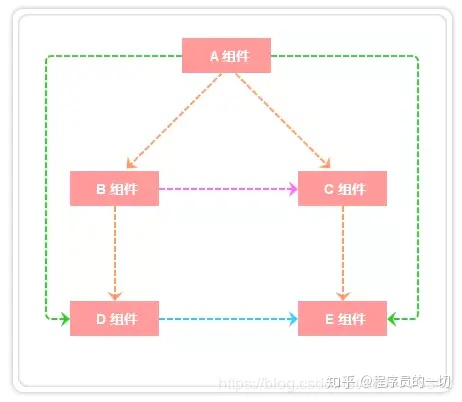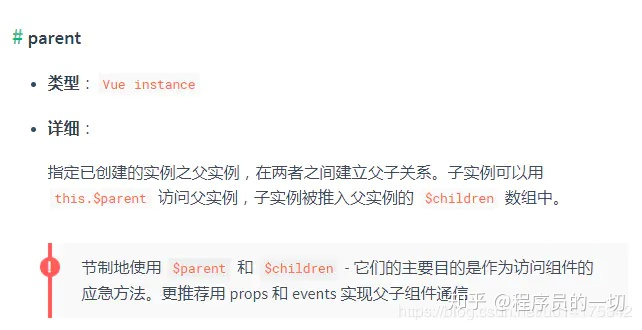Vue中8中组件通信方式

如上图所示, A与B、A与C、B与D、C与E组件之间是父子关系; B与C之间是兄弟关系;A与D、A与E之间是隔代关系; D与E是堂兄关系(非直系亲属) 针对以上关系我们归类为:
- 父子组件之间通信
- 非父子组件之间通信(兄弟组件、隔代关系组件等)
一、props / $emit
父组件通过props的方式向子组件传递数据,而通过$emit 子组件可以向父组件通信。
1. 父组件向子组件传值
下面通过一个例子说明父组件如何向子组件传递数据:在子组件article.vue中如何获取父组件section.vue中的数据 articles:['红楼梦', '西游记','三国演义']
// section父组件 <template> <div class="section"> <com-article :articles="articleList"></com-article> </div> </template> <script> import comArticle from './test/article.vue' export default { name: 'HelloWorld', components: { comArticle }, data() { return { articleList: ['红楼梦', '西游记', '三国演义'] } } } </script> 复制代码 // 子组件 article.vue <template> <div> <span v-for="(item, index) in articles" :key="index">{{item}}</span> </div> </template> <script> export default { props: ['articles'] } </script>
总结: prop 只可以从上一级组件传递到下一级组件(父子组件),即所谓的单向数据流。而且 prop 只读,不可被修改,所有修改都会失效并警告。
2. 子组件向父组件传值
对于绑定一个自定义事件, 当这个语句被执行时, 就会将参数arg传递给父组件,父组件通过v-on监听并接收参数。$emit 我自己的理解是这样的: $emit
// 父组件中 <template> <div class="section"> <com-article :articles="articleList" @onEmitIndex="onEmitIndex"></com-article> <p>{{currentIndex}}</p> </div> </template> <script> import comArticle from './test/article.vue' export default { name: 'HelloWorld', components: { comArticle }, data() { return { currentIndex: -1, articleList: ['红楼梦', '西游记', '三国演义'] } }, methods: { onEmitIndex(idx) { this.currentIndex = idx } } } </script> // 子组件 <template> <div> <div v-for="(item, index) in articles" :key="index" @click="emitIndex(index)">{{item}}</div> </div> </template> <script> export default { props: ['articles'], methods: { emitIndex(index) { this.$emit('onEmitIndex', index) } } } </script>
二、 $children / $parent

使用方法
// 父组件中 <template> <div class="hello_world"> <div>{{msg}}</div> <com-a></com-a> <button @click="changeA">点击改变子组件值</button> </div> </template> <script> import ComA from './test/comA.vue' export default { name: 'HelloWorld', components: { ComA }, data() { return { msg: 'Welcome' } }, methods: { changeA() { // 获取到子组件A this.$children[0].messageA = 'this is new value' } } } </script> 复制代码 // 子组件中 <template> <div class="com_a"> <span>{{messageA}}</span> <p>获取父组件的值为: {{parentVal}}</p> </div> </template> <script> export default { data() { return { messageA: 'this is old' } }, computed:{ parentVal(){ return this.$parent.msg; } } } </script>
注意:
要注意边界情况,如在#app上拿$parent得到的是new Vue()的实例,在这实例上再拿$parent得到的是undefined,而在最底层的子组件拿$children是个空数组。也要注意得到$parent和$children的值不一样,$children 的值是数组,而$parent是个对象
总结
上面两种方式用于父子组件之间的通信, 而使用props进行父子组件通信更加普遍; 二者皆不能用于非父子组件之间的通信。
三、provide/ inject
见https://zhuanlan.zhihu.com/p/151831447


